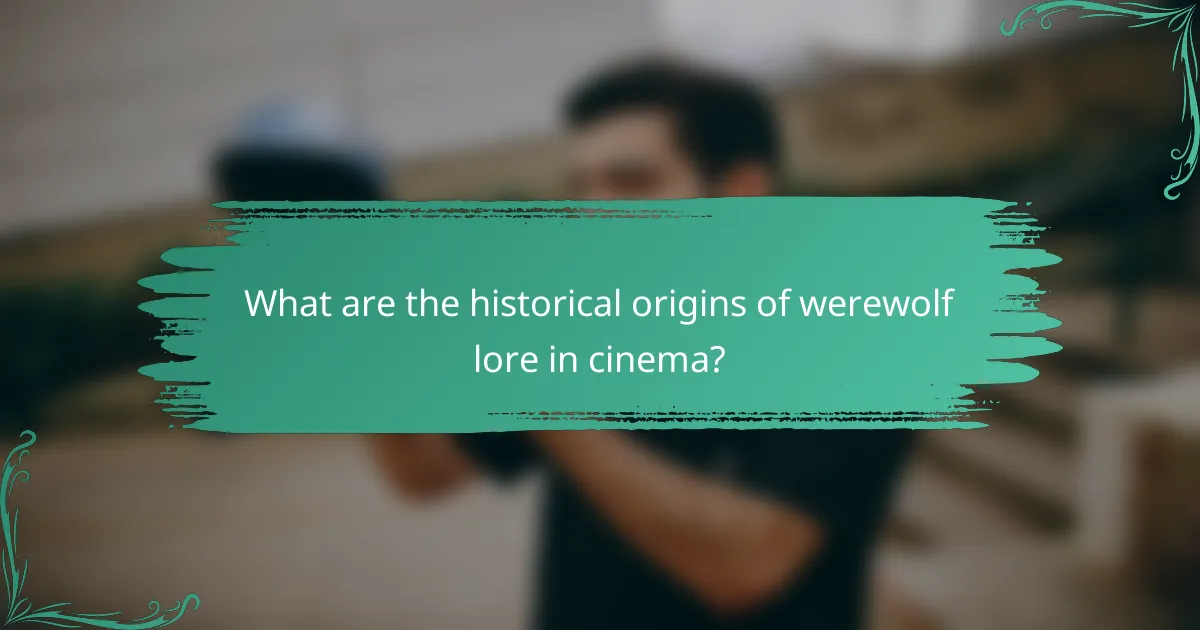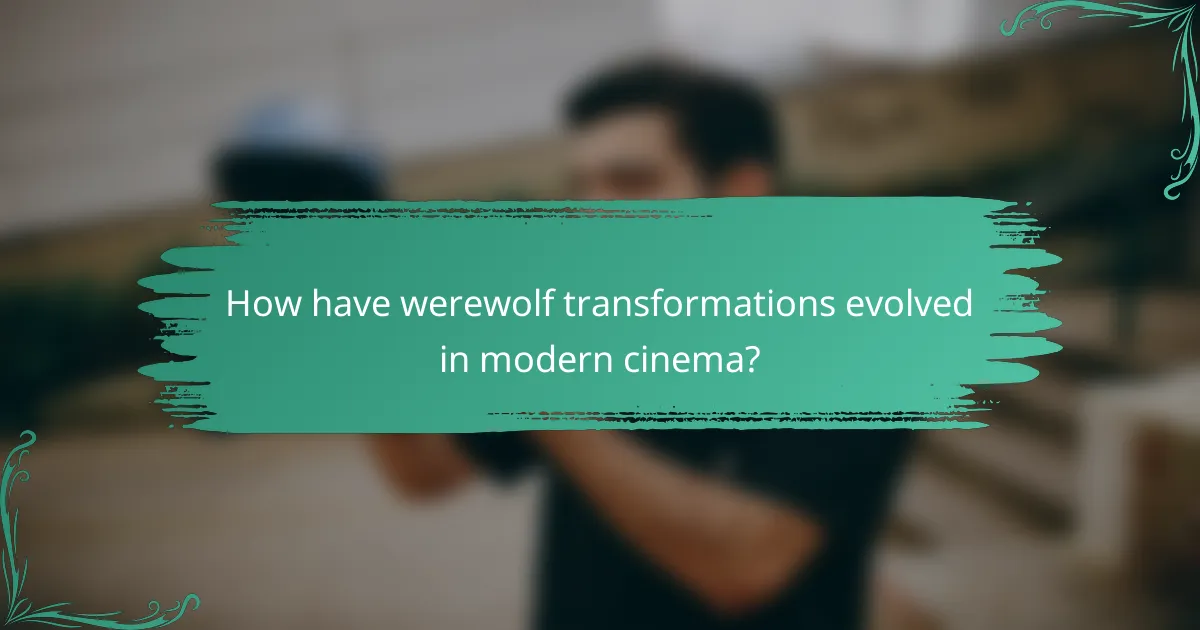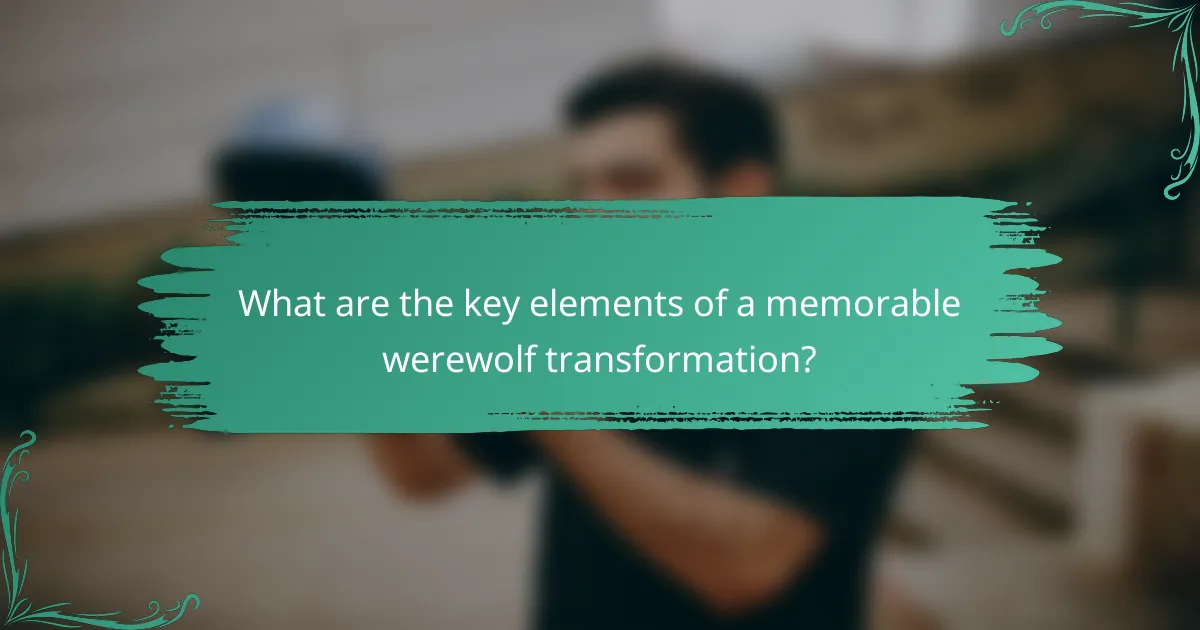Iconic werewolf transformations in classic cinema are not only visually stunning but also rich in emotional depth, capturing the eternal conflict between humanity and primal instincts. These transformative moments have evolved through various techniques, from practical effects to CGI, each contributing to the genre’s lasting impact on popular culture and horror storytelling.
![]()
What are the most iconic werewolf transformations in cinema?
The most iconic werewolf transformations in cinema are characterized by their dramatic visual effects and emotional intensity. These moments often symbolize the struggle between humanity and primal instincts, leaving a lasting impact on audiences.
Transformation in “An American Werewolf in London”
The transformation scene in “An American Werewolf in London” is renowned for its groundbreaking special effects. Directed by John Landis, the sequence showcases a painful and visceral metamorphosis, with the protagonist, David, experiencing excruciating physical changes over several minutes.
This transformation is notable for its practical effects, created by Rick Baker, which earned him an Academy Award. The combination of makeup, animatronics, and physical acting creates a hauntingly realistic depiction of becoming a werewolf.
Transformation in “The Howling”
The transformation scene is both graphic and surreal, showcasing the character’s struggle against their new identity. The use of shadows and lighting enhances the eerie atmosphere, making it a memorable moment in horror cinema.
Transformation in “Wolfman”
With a focus on CGI and practical effects, the film captures the horror of the transformation through intense visual storytelling. The emotional weight of the character’s struggle adds depth to the transformation, making it resonate with viewers.
Transformation in “Ginger Snaps”
This film emphasizes the psychological aspects of transformation, showcasing how Ginger’s character evolves alongside her physical changes. The use of practical effects enhances the authenticity of her metamorphosis, making it both relatable and horrifying.
Transformation in “Teen Wolf”
While the effects are less graphic compared to other films, the transformation is significant in its portrayal of teenage struggles. The blend of humor and supernatural elements makes it a memorable and iconic moment in pop culture.

How do werewolf transformations differ across films?
Werewolf transformations vary significantly across films in terms of technique, style, and thematic depth. Some films employ practical effects to create a visceral experience, while others rely on CGI for more fluid and fantastical transformations.
Practical effects vs. CGI in “An American Werewolf in London”
“An American Werewolf in London” is renowned for its groundbreaking practical effects, particularly the transformation scene, which took several hours to create using makeup and animatronics. This hands-on approach provides a tangible realism that resonates with audiences, making the transformation both shocking and memorable.
In contrast, CGI has become a popular choice in modern filmmaking, allowing for more dynamic and exaggerated transformations. While CGI can enhance visual storytelling, it sometimes lacks the raw intensity that practical effects deliver, leading to a different viewer experience.
Symbolism in “The Howling”
“The Howling” uses werewolf transformations to symbolize the struggle between civilization and primal instincts. The transformation scenes reflect the characters’ inner turmoil and the loss of control, emphasizing themes of identity and societal norms.
This film also explores the idea of embracing one’s true nature, as the characters grapple with their newfound abilities. The transformation serves as a metaphor for liberation from societal constraints, inviting viewers to consider the duality of human nature.

What are the cultural impacts of werewolf transformations?
Werewolf transformations have significantly influenced popular culture, particularly in horror films, by symbolizing the struggle between civilization and primal instincts. These transformations often reflect deeper societal fears and the complexities of human nature, resonating with audiences across generations.
Influence on horror genre conventions
The werewolf transformation is a pivotal trope in horror cinema, establishing a framework for suspense and fear. Classic films like “The Wolf Man” and “An American Werewolf in London” showcase the transformation as a moment of terror, often accompanied by dramatic visual effects and sound design that heighten the emotional impact.
This trope has set standards for other horror films, influencing the portrayal of monsters and the use of transformation as a narrative device. The visceral nature of the transformation scene often serves as a climax, reinforcing the horror genre’s reliance on physical and psychological metamorphosis.
Representation of human-animal duality
Werewolf transformations vividly illustrate the human-animal duality, showcasing the conflict between civilized behavior and primal instincts. This duality resonates with audiences, as it reflects the inner struggles individuals face between societal expectations and their raw, instinctual nature.
Films often depict this struggle through the transformation process, where characters grapple with their emerging animalistic traits. This representation invites viewers to explore themes of identity, morality, and the consequences of losing control, making the werewolf a compelling symbol of humanity’s darker impulses.

What are the historical origins of werewolf lore in cinema?
The historical origins of werewolf lore in cinema can be traced back to ancient myths and folklore that depicted humans transforming into wolves. These narratives have evolved over centuries, influencing early films and shaping the portrayal of werewolves in modern cinema.
Folklore influences on early films
Early films drew heavily from European folklore, where tales of lycanthropy were common. Stories of individuals cursed to transform into wolves during the full moon were prevalent, particularly in regions like France and Germany. These narratives provided a rich backdrop for filmmakers, leading to iconic adaptations such as “The Wolf Man” in the 1940s.
Folklore often depicted werewolves as tragic figures, caught between their human and animal natures. This duality became a central theme in early cinematic portrayals, emphasizing the struggle between civilization and primal instincts.
Evolution of werewolf mythology in Hollywood
As Hollywood evolved, so did the mythology surrounding werewolves. The 1930s and 1940s marked a significant shift, with films beginning to explore werewolves as complex characters rather than mere monsters. This change reflected societal fears and anxieties, particularly during times of war and social upheaval.
In contemporary cinema, werewolf transformations have become more sophisticated, often utilizing advanced special effects and makeup techniques. Films like “An American Werewolf in London” showcased groundbreaking transformation scenes, blending horror with dark humor and further expanding the werewolf mythos.

How have werewolf transformations evolved in modern cinema?
Werewolf transformations in modern cinema have significantly advanced due to technological innovations and changing narrative themes. Filmmakers now utilize a blend of practical effects and digital enhancements to create more realistic and emotionally resonant transformations.
Use of advanced CGI in “The Wolfman”
“The Wolfman,” released in 2010, showcases the integration of advanced CGI techniques to enhance the werewolf transformation process. The film combines traditional makeup effects with computer-generated imagery to achieve a seamless and terrifying transformation that captivates audiences.
One notable aspect is the detailed rendering of fur and facial features, which allows for a more lifelike appearance. This blend of practical and digital effects sets a new standard for how transformations can be portrayed on screen.
Contemporary themes in “Howl”
“Howl,” a 2015 film, explores contemporary themes of identity and societal fear through its werewolf narrative. The transformation in this film is not just physical but also symbolic, reflecting the internal struggles of the characters as they grapple with their primal instincts.
This thematic depth adds layers to the transformation scenes, making them more than just visual spectacles. The film invites viewers to consider the implications of losing control and the duality of human nature, which resonates with modern audiences seeking more than mere horror.

What are the key elements of a memorable werewolf transformation?
A memorable werewolf transformation typically includes a combination of physical changes, emotional intensity, and atmospheric elements. These transformations often evoke a sense of horror and fascination, showcasing the struggle between humanity and primal instincts.
Physical Changes
Physical changes during a werewolf transformation are crucial for creating a striking visual impact. This often involves the gradual alteration of body shape, hair growth, and facial features, which can be enhanced through practical effects or CGI. Classic films frequently emphasize the grotesque nature of these changes, making them both captivating and unsettling.
For instance, the iconic transformation scenes in movies like “An American Werewolf in London” utilize makeup and special effects to depict the painful metamorphosis. The use of realistic sound effects can amplify the horror, making the audience feel the character’s agony.
Emotional Intensity
The emotional intensity of a werewolf transformation adds depth to the experience. Characters often grapple with fear, anger, and confusion as they lose control over their humanity. This internal struggle can resonate with viewers, making the transformation more impactful.
In films, showcasing the character’s emotional turmoil before and during the transformation can create a strong connection with the audience. For example, scenes that highlight the character’s desperation or regret can enhance the overall narrative and make the transformation feel more significant.
Atmospheric Elements
Atmospheric elements play a vital role in setting the tone for a werewolf transformation. Lighting, sound design, and location can all contribute to the overall mood. Dark, shadowy settings combined with eerie soundscapes can heighten the tension and anticipation leading up to the transformation.
Classic werewolf films often employ a mix of these atmospheric elements to create a memorable experience. For example, the use of a full moon as a backdrop not only signifies the transformation but also adds a layer of folklore that enriches the story. Incorporating these elements thoughtfully can elevate the transformation from a mere visual spectacle to a compelling narrative moment.